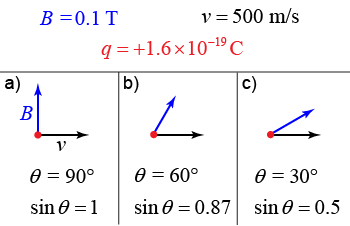|
When a charged particle moves within a magnetic field, it feels a force. The force vector is perpendicular to the magnetic field and to the particle’s velocity vector; this means that the force often causes charged particles to follow curved paths. The strength of the force is proportional to the magnetic field strength, the particle’s charge, and the particle’s speed. This force has many practical applications because it can separate particles with differing masses or electrical charges. 
|
|
mass spectrometer, cyclotron radius, permeability of free space, voice coil, galvanometer, cathode ray tube (CRT)
|
|
|
|
Review problems and questions |
|

- As shown here, the right-hand rule tells us the direction of the force on a positively charged particle that moves with velocity v through a magnetic field B. The first magnetic spectrometer shows the trajectories of positively charged particles entering from the left. What is the sign (+ or −) of the particle charge in Case (a) and Case (b)? The magnetic field emerges from the page toward the viewer in all three spectrometers.


|
Answer: In Case (a), the particles are negatively (−) charged. In Case (b), the particles are positively (+) charged. 
|
- In each spectrometer shown on this page, three charged particles enter with identical velocities, but soon they follow different paths. Which of the following could explain why their paths diverge? (Recall that each of the three particles is in the same magnetic field.)
- The particles have differing masses.
- The particles have differing amounts of electric charge.
- Either a or b.
- Neither a nor b.


|
Answer: Choice c is correct: You can change a moving charged particle’s radius of curvature either by changing its mass or its electric charge. (More precisely, the radius of the path is larger when the particle’s mass-to-charge ratio, or m/q, is larger. This means that doubling a particle’s mass and its charge would leave its gyroradius unchanged.) 
|

- Calculate the strength of the electromagnetic force upon the positive charge in each of these three cases. (Note that the force will point toward you, at right angles to the page, since the charge is positive and the magnetic field and velocity vectors both lie in the plane of the page.) The field strength, speed, and charge remain constant; only the angle between the two vectors is varied.


|
Answer: - FB = 8.0×10−18 N.
- FB = 6.9×10−18 N.
- FB = 4.0×10−18 N.
Solution:
Asked: force FB
Given: magnetic field strength B = 0.1 T; speed v = 500 m/s; charge q = +1.6×10−19 C;
angle θ = 90°, 60°, or 0°
Relationship: FB = qvB sin θ
Solution: Since the only term that varies among the three cases is sin θ, let’s first calculate the product qvB: The three sine terms are 1.0, 0.87, and 0.5, respectively. Multiplying qvB by these terms produces the three forces. Note that the force is greatest when the particle moves at right angle to the field. Note, too, that the acceleration of an ion would be enormous, even though this force is tiny, because the ion has a very low mass. 
|
Take a Quiz |

